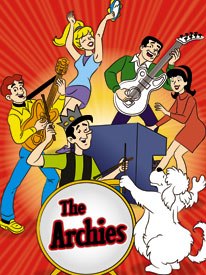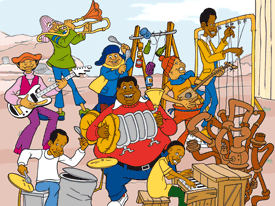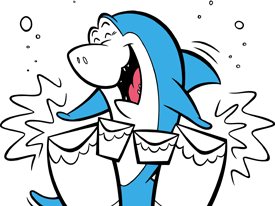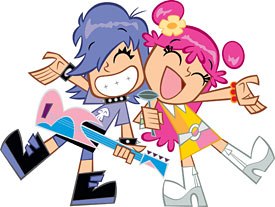This month, Dr. Toon takes a psychedelic trip back to the late ‘60s and early ‘70s when Saturday Morning cartoons rocked.

The popular music of the 1960s and 1970s is now considered classic rock. This is a rather mordant term to those of us who flocked down to the record shop when these albums first came out. We would then groove to them as they played on our stereos. As I am now a classic person at age 50, I remember all those great bands currently on reunion tours, still shakin all over (well, at least in their arms and midsections). I could go on about this Paleozoic paradise, but I would only frustrate my readers and date myself further. Therefore, I will mercifully change gears at this point (except to brag that I paid $7.50 top price for my concert ticket to see Pink Floyd in 73). Instead, let us explore a phenomenon of that same period also having to do with bands. However, these performers were neither classic nor great, and will never be doing reunion tours.
From 1966-1974, one Saturday morning program after another featured rock bands. Most of them were composed of teenagers, although there were a couple of notable exceptions. Before exploring them in more detail, it is worth examining how this plethora of animated rock bands came to be in first place. The best place to start is with the first British Invasion (roughly 1965-1967). During this incredibly exciting time, rock and roll bands from England began a fruitful cross-pollination with American folk and rock and roll. Within two years, the styles between American and British rock were so similar as to be indistinguishable The Brits sent The Beatles, The Dave Clark Five and Hermans Hermits, to name a few, over to the states. The Rolling Stones, the Kinks and the Who other early entries in the game added a tang of the blues to the mix as well.
However, the above bands added other elements that would affect the depiction of rock music on animated shows of the 1960s and 1970s. One may or may not agree with critics who assert that The Beatles Sgt. Peppers Lonely Hearts Club Band (1967) was the template for all future rock music, but the album certainly influenced the style of numerous rock genres. It was also a trippy piece of work, constantly hinting at the clandestine pleasures of mind-altering substances. A recreational drug culture was flourishing, and psychedelia bloomed with The Grateful Dead, Jefferson Airplane and other California bands leading the way. Sexual proclivity, the animating sprit of rock and roll since its inception, was now stated openly rather than alluded to in many, if not most, rock tunes.
This greatly abridged (and by no means inclusive) history highlights two problems for programmers looking to integrate the tremendously popular sound of rock with animated cartoons. There was little sense of the animated medium as entertainment for adults during the heyday of rock; animation was largely childrens fare wedged into a four-hour block on Saturday mornings. Sex, drugs and rock and roll were just fine, as long as the sex and drugs were stringently weeded out. It is prudent to recall that the late 1960s/early 1970s represented the genesis of the watchdog movement. If rock found its way into animated shows and series, it would not be represented by the music of Jimmy Page, Ozzy Osbourne, Angus Young or Jim Morrison.
Networks had a template of sorts. From 1965-1967 (not counting reruns) King Features hit it big with the animated adventures of the Beatles. ABC snapped up the series and aired the Fab Four on Saturday mornings to the delight of younger fans. At roughly the same time, live-action viewers met up with the Monkees. This wholesome young quartet had mod adventures and sang groovy songs (penned and performed by other pop artists). The Monkees were possible early progenitors of the boy-band phenomenon and the music video, two irresistible forces in modern pop culture. The Monkees also influenced millions of young fans to buy their records, merchandise, trading cards and anything that could be stamped with a Monkees logo. Neither the Monkees nor the cartoon Beatles were likely to be dropping hits of acid or moaning for raunchy sex in their songs. However, one more ingredient remained for future animated success.
During the mid 1960s/early 1970s a more innocuous, less suggestive subgenre of rock music emerged. Critics christened this form bubblegum. Music of this sort was actually closer to pop and was identifiable by simplicity of musical structure, catchy, repetitive hooks and a puppy-love perspective on sex. Bubblegum was bouncy enough for airplay, innocent enough for most parents and highly marketable to the demographic we now call tweens. Bubblegum and Saturday morning animation were natural partners, especially whilst the watchdogs were calling for an end to ultraviolent superhero cartoons. Sweetening the marriage was the fact that animated kids were performing the rock music; audiences could readily identify with them. Nowhere was this more evident than in Filmations 1968 series, The Archie Show.

Archie Andrews and company were nothing new. The squeaky-clean teens had actually been hanging out in comicbooks since 1941. When Filmation exercised the rights to an animated version of the property in 1968, CBS bought it with the direct purpose of creating an animated doppelganger of the Monkees. The network went so far as to hire rock promoter Don Kirschner, the father of the Monkees, to fine-tune the show with some fine tunes. These efforts resulted in a show that grabbed 75% of the Saturday morning audience and spawned a number one hit, Sugar Sugar (1969). ABC, quick on the uptake, bought a second Filmation series, The Hardy Boys. Like Archie, The Hardy Boys had a long print history; the sleuthing brothers had been starring in boys adventure novels since 1927. In the 1960s, the boys formed a rock band, which was promptly incorporated into the animated series.
If the entertainment industry is notable for anything, it would be the replication of popular and profitable ideas. Soon every Saturday morning series during the 1970s seemed to overflow with peppy young songsters who played their tunes with the aplomb of, well, the Monkees. The decade opened with one of the most iconic and beloved of the genre, Josie and the Pussycats (1970). Significantly, this series was a spin-off featuring characters created under the Archie aegis. The titular band was a trio of cheerful chicks chirping in cheetah suits while having outlandish adventures. Some believe that this series was the ne plus ultra of Saturday morning animation circa 1970; they may well be right, since virtually everything went downhill after that.
1971 saw such wretched entries as The Groovie Goolies, another Filmation/Archie spin-off featuring a moronic band comprised of monsters. The Flintstone and Rubble offspring managed to front the blandest band in the land in Pebbles and Bamm-Bamm, and the Jackson 5ive checked in as animated versions of themselves. The series was poorly written and animated, but the Jacksons fusion of bubblegum and the Motown sound lent at least a little bounce to the ABC lineup. Far worse was to come; the animated lineup from 1972-1973 was enough to ruin a generation of audiophiles.

The Amazing Chan and the Chan Clan featured the clan at their musical worst. Audiences discovered that The Brady Kids (late of the Brady Bunch) were totally bereft of both songwriting ability and any modicum of talent. The Osmonds, every grandmothers ideal version of a rock band, took their cue from the Jackson 5ive and sullied the reputations of both the Rankin-Bass studios and the venerable house of Halas-Batchelor. The most appealing maestros of the bunch were Fat Albert and the Cosby Kids, who performed their rock offerings on improvised junkyard instruments. Were the songs not undercut by repetitive animation or burdened with moralistic messages, the entire presentation might have had more appeal.
By 1973, the fad was virtually over. Hanna-Barbera produced an atrocity called Butch Cassidy and the Sun Dance Kids for NBC. The following year, the last entry in the genre of live-action bands transferred to cartoon form straggled in. Partridge Family: 2200 AD was every bit as ridiculous as it sounded, but by then no one cared. The last surviving rock band appeared in 1976, and it was fronted by a cartoon shark-cum-drummer named Jabberjaw. At this point, I invite the readers to visualize an actual shark behind a set of drums. With the advent of the music video around 1980, there was brief revival of the animated rock band, notably with Jem, New Kids on the Block and a silly entry called Kidd Video. Still, the format was essentially dead.

Why should this be, especially in an age where kids seemingly have iPods and MP3 players surgically grafted on to their bodies? Music seems to be reaching into increasingly diverse demographics; why arent todays commercial cartoon characters more musically inclined? There have been a few, such as the gals of Hi Hi Puffy Ami Yumi, Atomic Betty and the fly fly featured in The Buzz on Maggie. Those would be minor chords when one compares the amount of animated fare available today as opposed to the amount aired in 1972. The answer is actually quite simple, but it still took some time to dawn on the networks he gimmick of having animated characters playing in a rock band never enhanced a single cartoon.
If anything, the music detracted from the quality. First, the action (such as it was) often had to be halted to wedge in musical numbers, or a repetitive chase scene had to take place for the music to play behind. Second, the rock band format tended to make the characters less, rather than more believable. It taxed the imagination that anyone could simply pick up instruments and burst into carefully rehearsed song at any given moment; it is (one of) the reasons that the musical is a defunct cinematic form today. Third, the quality of the music was generally putrid. Bubblegum was not exactly the most interesting and flexible form of rock music to begin with; when turned out under the deadlines of television series production; it sank to an even lower level. Fourth, when many series were tossing rock bands into the format, the novelty wore off rapidly. Recall that The Archie Show predated the heyday of animated rock bands by five years.
Finally, having everyone cast as a musician or rock star did not always fit the character of the cartoons. Did having a band make the Hardy Boys more proficient detectives, or did Pebbles and Bamm-Bamm really need re-casting as rockers to retain the appeal they had for decades?
Thus, we come full circle. Once upon a time, there was an animated show called The Beatles. The series was a very good one, fondly remembered by many today. The animated musicians were very believable, because they were depictions of real musicians. The writing was built around the music: The music was excellent. The animated series was the first of its kind, derivative of nothing else. Since the series never got around to depicting the post-1967 version of the band, everything could be good, clean fun. In other words, The Beatles contained none of the flaws described above, and stands as the best of the genre. Granted, the Beatles were gods, whereas the Sun Dance Kids were idiosyncratic footnotes to animation history. Still, in viewing the wreckage, the saga of animated rock bands during the 1960s and 1970s is a rather sad one unlikely to be repeated anytime soon.
Martin Dr. Toon Goodman is a longtime student and fan of animation. He lives in Anderson, Indiana.







